History
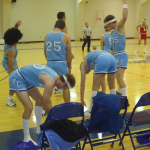
 I was reading a cartoon yesterday morning in the newspaper…which is rather unlike me, because I don’t usually read the comics. Nevertheless, this one stood out to me, and so I read it. In this comic, a boy is looking at his dad’s high school year book, and the basketball team that his dad was on. Well, in those days, the shorts were short. The boy commented that with, “Too much leg Dad. It’s disturbing!” Upon reading this, I was taken back to the 1970s, when everyone wore short shorts…especially in sports. Of course, there was another thought that came to mind. When did kids start talking that way…disturbing…seriously!! In my day, we wouldn’t have used that word. It wasn’t that we didn’t know big words, it was just that in the era of slang, we didn’t conform to our parents way of talking. It almost sounds like kids are little grownups these days.
I was reading a cartoon yesterday morning in the newspaper…which is rather unlike me, because I don’t usually read the comics. Nevertheless, this one stood out to me, and so I read it. In this comic, a boy is looking at his dad’s high school year book, and the basketball team that his dad was on. Well, in those days, the shorts were short. The boy commented that with, “Too much leg Dad. It’s disturbing!” Upon reading this, I was taken back to the 1970s, when everyone wore short shorts…especially in sports. Of course, there was another thought that came to mind. When did kids start talking that way…disturbing…seriously!! In my day, we wouldn’t have used that word. It wasn’t that we didn’t know big words, it was just that in the era of slang, we didn’t conform to our parents way of talking. It almost sounds like kids are little grownups these days.
So much has changed since the 70s. From the styles to the way kids talk. When I was a kid, the only time most guys wore shorts was when they were playing basketball or some such sport. My husband, Bob never wore shorts until about the last ten or fifteen years. It was like he thought that shorts on a man made him a wimp. Of course, by the time Bob started wearing shorts, they were to the knee or a little below on the men, so it just felt different. In many ways, I suppose the short shorts on the men was…disturbing. I can’t say exactly why it is ok for a girl to wear short shorts, and not a man, but somehow it just is.
As the young man in the comic got done telling his dad that short shorts on men were disturbing, the dad, made the commented that he had come from a time when “shorts were worn above the ankle.” That made me laugh, at the thought of the shorts on men going almost to their ankles. It would be even funnier, if it weren’t so close to the truth. Not only are the shorts now, the length of a woman’s Capri pants, but they are totally baggy…as are the pants. In the 70s, the men wore tight pants like the girls do now. To me, today’s baggy style has a sloppy look, but it is the style of the young, and their choice. I don’t say that men need to wear their pants skin tight, but it is nice if they stay up without suspenders.

 As to short shorts in sports, there are those sports, such as track, where clothing needs to be more form fitting so as to be out of the way, but in sports like basketball, they maybe should be a little bit longer and loose. I suppose it depends on the athlete and their style and comfort, and on the school and the style of uniforms they choose and that they can get. In the 70s, I doubt there were any basketball uniforms for boys that had long baggy shorts, so to have a uniform, schools had to go with what they could get. That was just the way it was. Sorry kids of today, back then, shorts were actually above the ankle.
As to short shorts in sports, there are those sports, such as track, where clothing needs to be more form fitting so as to be out of the way, but in sports like basketball, they maybe should be a little bit longer and loose. I suppose it depends on the athlete and their style and comfort, and on the school and the style of uniforms they choose and that they can get. In the 70s, I doubt there were any basketball uniforms for boys that had long baggy shorts, so to have a uniform, schools had to go with what they could get. That was just the way it was. Sorry kids of today, back then, shorts were actually above the ankle.
 In their early years, the railroads were quite powerful companies, and with good reason. The railroad reduced travel time across the United States from days or months, to hours, in many cases. They brought supplies, payroll, and people from back east to the west quickly. The railroad did not come without some confusion, however. Even as late as the 1880s, most United States towns had their own system for keeping track of time, based on where the sun was at high noon. I had never given much thought to this, but I suppose it could have been a big mess, since the train’s arrival would be very mixed up, and the end result would be that the train might be scheduled to arrive in several places at once.
In their early years, the railroads were quite powerful companies, and with good reason. The railroad reduced travel time across the United States from days or months, to hours, in many cases. They brought supplies, payroll, and people from back east to the west quickly. The railroad did not come without some confusion, however. Even as late as the 1880s, most United States towns had their own system for keeping track of time, based on where the sun was at high noon. I had never given much thought to this, but I suppose it could have been a big mess, since the train’s arrival would be very mixed up, and the end result would be that the train might be scheduled to arrive in several places at once.
Because the railroads were quite powerful, they took it upon themselves to make a monumental change that would affect the entire nation, and Canada too. At exactly noon on this day in 1883, American and Canadian railroads broke the continent into four sections, and began using a system of time zones that we still use to this day, with very few changes made to it over the years. I’m sure there were people who did not like the new system much, but most people quickly embraced it, because their lives depended on the railroad in one way or another. The root of the problem they had was that they moved passengers and freight over the thousands of miles the line covered. With the varying times in towns along the route, the train 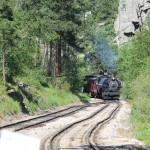 ended up with dozens of different departure and arrival times. No one really knew when the train would arrive…except possibly the engineer. I’m sure that caused chaos in the train stations…especially in the bigger cities. These days, we have to be at the airport two hours early for flights, because of screening, so imagine that kind of a scenario in the small train stations of the old west. This scheduling nightmare had to be stopped, and time zones were the only logical way to do it.
ended up with dozens of different departure and arrival times. No one really knew when the train would arrive…except possibly the engineer. I’m sure that caused chaos in the train stations…especially in the bigger cities. These days, we have to be at the airport two hours early for flights, because of screening, so imagine that kind of a scenario in the small train stations of the old west. This scheduling nightmare had to be stopped, and time zones were the only logical way to do it.
With the use of time zones, rail transportation became far more efficient. The thing that seems rather odd, is that they didn’t go to the United States or Canadian governments to resolve the problem, and if the government at that time was as inefficient as our congress is right now, I can fully understand why they didn’t. Imaging waiting six years to make a decision concerning time and its vital role in rail travel. Something had to be done right away, and the railroad was just bold enough to do it. As it turned out, no one tried to stop them either. I suppose everyone could see just how logical their plan was, and no one complained. So, the railroad companies agreed to create four continental time zones, and that decision has changed the way we live to this day.
The lines they adopted to make those time zones were very close to the ones we have today. I’m sure that any changes are based on where towns began to fall along the zone lines. It wasn’t until as late as 1918 that Congress officially adopted the railroad time zones and put them under the Interstate Commerce Commission.  Just imagine, if you will, if the people and the railroad had waited for Congress to act on this matter. There would have been 35 more years of unorganized and frustrating railroad travel. Something that should have revolutionized travel, would have been relegated to the stone age again, because of Congress’ lack of action. Even after the system was implemented and people finally had an organized schedule, that was relatively accurate…because you can’t predict accidents or weather related delays very well, Congress sat on their hands, and I suppose they operated the government on government time instead. In this writer’s opinion, the time zones were a wonderful idea, and have benefitted this nation very well since 1883. My family has a long history of working on the railroad, and that is a fact that I am very proud of.
Just imagine, if you will, if the people and the railroad had waited for Congress to act on this matter. There would have been 35 more years of unorganized and frustrating railroad travel. Something that should have revolutionized travel, would have been relegated to the stone age again, because of Congress’ lack of action. Even after the system was implemented and people finally had an organized schedule, that was relatively accurate…because you can’t predict accidents or weather related delays very well, Congress sat on their hands, and I suppose they operated the government on government time instead. In this writer’s opinion, the time zones were a wonderful idea, and have benefitted this nation very well since 1883. My family has a long history of working on the railroad, and that is a fact that I am very proud of.
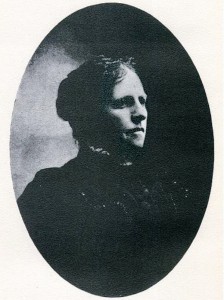 When Hattie Goodman, who is my husband, Bob’s 3rd cousin 4 times removed, wrote her family history book about the Knox family, back in 1905, computers and the internet were far in the future. The Knox family knew that their roots were is Scotland, but during her lifetime, the connection was never made. Having searched, fruitlessly at times, for my own roots, I can relate to the frustration she must have felt at hitting that brick wall. I can’t imagine how slow the process must have been when the only ways to search the records were by mail or a personal visit to the city whose records you were researching…or word of mouth, which can be highly unreliable. Her own search ended with her passing, but since that time, much has changed in the genealogy realm.
When Hattie Goodman, who is my husband, Bob’s 3rd cousin 4 times removed, wrote her family history book about the Knox family, back in 1905, computers and the internet were far in the future. The Knox family knew that their roots were is Scotland, but during her lifetime, the connection was never made. Having searched, fruitlessly at times, for my own roots, I can relate to the frustration she must have felt at hitting that brick wall. I can’t imagine how slow the process must have been when the only ways to search the records were by mail or a personal visit to the city whose records you were researching…or word of mouth, which can be highly unreliable. Her own search ended with her passing, but since that time, much has changed in the genealogy realm.
While she was unable to link the Knox family to Scotland, that link has since been made. According to John Knox, of the Knox-Laffoon clan, “John Knox, emigrant progenitor, represented by the trunk of our Knox Family Tree, was a native of Scotland, born about the year 1708. The exact locality of his birthplace is not certainly known. Some of the descendants on two different branches have it by tradition that Renfrewshire was his native place. He went from Scotland to Ireland, with other Scotch emigrants, by invitation of the King of England, to constitute a balance of power against the insurgent Irish Catholics. He married an Irish Presbyterian wife, Miss Jean Gracy, whose mother’s name was Jean Sinclair. They emigrated to America (from Coleraine, Ireland) about 1740, in company with his brother-in-law, Patrick Gracy, and others. It is thought that he first settled in Pennsylvania before coming South to Carolina. He was one of the early settlers of Rowan county, N. C. He bought six hundred acres of land on the south side of Third Creek for £37, 10s., which land had been granted by Earl Granville to James Stuart.”
At some point, my father-in-law, Walter Schulenberg, who had married my mother-in-law, Joann Knox, was given a CD containing much of the history of the Knox family, in the form of Hattie Goodman’s book and many family pictures. I downloaded that to my computer, and have since very much enjoyed reading her writings, and especially enjoyed all the pictures that were included. I have used several of them in previous writings about the Knox family. What a wonderful thing for someone to have transferred all that information to a CD, where it could be shared and enjoyed by so many people. Originally, Reverend James Knox drew a sketch of his family tree, as far back as he knew. During Hattie’s lifetime, she was able to add many people to the original tree, and in the end produced a wonderful heirloom tree with about 2,200 names on it. Many copies were made and given to various family members. I was privileged enough to be able to see one of those copies when Bob and I visited 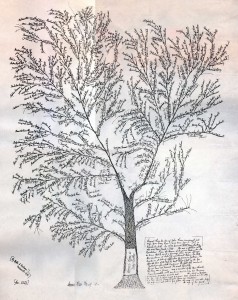 his great grandparents, Edgar and Nellie Knox in September of 1976. It was a magnificent tree, and while I can provide a copy here, it could never be as impressive as the extra large one I got to see.
his great grandparents, Edgar and Nellie Knox in September of 1976. It was a magnificent tree, and while I can provide a copy here, it could never be as impressive as the extra large one I got to see.
I suppose that many people might think that today’s ability to research family histories is almost cheating, but I think it is better to be able to find the answers…even if it’s taking the easy way, than never to find the answers at all. These days, the research has gone far beyond pouring over records stored in some dark basement room at city hall. Besides the internet, and the vast amount of records that are shared there every day, there are also DNA connections. I have had my DNA analyzed, and have connected with many family members from that one test. It is amazing how far we have come, and I think that in the future, we may find ourselves even closer to being able to connect to our roots, be they Scottish or one of the many other nationalities.
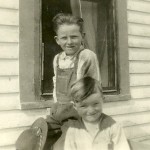 Opinions vary on the matter of child labor, and who can legally have their child work and at what kind of job. Some people take it to the point of saying that children shouldn’t even do chores around the home, which is, in my opinion, silly. It is my thought that children need to be helping out around the house, but beyond that I suppose the water gets a little bit murky. In the distant past, children were farmed out to spend their days working at a job that should have been done by an adult, and the kids really had no childhood to speak of. That is cruel treatment, and the current child labor laws prevent that from happening…unless people are so illegal that they do it without the knowledge of the government.
Opinions vary on the matter of child labor, and who can legally have their child work and at what kind of job. Some people take it to the point of saying that children shouldn’t even do chores around the home, which is, in my opinion, silly. It is my thought that children need to be helping out around the house, but beyond that I suppose the water gets a little bit murky. In the distant past, children were farmed out to spend their days working at a job that should have been done by an adult, and the kids really had no childhood to speak of. That is cruel treatment, and the current child labor laws prevent that from happening…unless people are so illegal that they do it without the knowledge of the government.
That said, there is a group of kids…even today that do work every day, and it is not illegal at all. These are the children of farmers and ranchers. I don’t know of any of those kids who don’t help out around the farm or ranch. There are stables to be cleaned, and cows to be milked, and animals to feed. There are also crops to be cared for and planted. These kids work and there is nothing illegal about it. Of course, their parents do have to 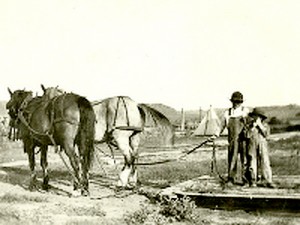 be careful on a few matters. The children must get their schooling, and they have to be working on the parents farm or ranch.
be careful on a few matters. The children must get their schooling, and they have to be working on the parents farm or ranch.
Such was the case for my husband’s great uncles and his grandfather. Many people owned farms when those boys were young, and the kids helped out with just about everything. Most families back then really couldn’t afford to hire the amount of workers that it would take to run the place, so they hired what they had to, and the kids learned to work. I really can’t say that I think this is a bad thing. The kids often like the work…especially taking care of horses…since they often get to ride them too.
If you look back on the lives of our parents and grandparents, you will find that many of them grew up on a farm or ranch, and most of them were working to help out on the place at a very young age. Really, what a wonderful way to bond with the parents. Running a ranch or farm is a big job, and most kids like to do the things their parents are doing, because they want to be just like their parents. If a child is interested in doing the same kind of work their parents do, or take over the family farm, they need to know how to do this from the bottom up. What better way could there be, than to help out as a child.

Of course, not every family owns a farm or ranch, and while they may live in the country, they don’t have that kind of work to do. Still, the kids can and should help out with things. My nephew, Barry Schulenberg, loved helping his grandpa split firewood. He ran the splitter while his grandpa loaded the wood into it. Barry was about 4 years old, but you couldn’t have pulled him away from that job for anything. He was the one who did that, and that was all there was to it. Maybe some people would think he was a bit young, but there was never a single accident when he worked the splitter. I think sometimes we don’t give these kids enough credt. They can often do more than we think they can. They just need to be given a chance.
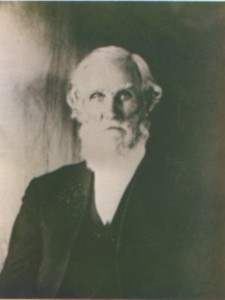 For some time now, my Shaw family line has been stalled at Angeloah, who is my 3rd great grandfather. I have always known that he was my grandfather, and that he was a religious man, but other than that, he has remained a mystery to me. Most of the time when a side of my family history stalls, I just move to another branch, because at that point I need a break from the frustration of a fruitless search. That is what I had done on that branch, until I was contacted by a man who was researching a Shaw branch of his family. So far, I have not found a connection between his family and mine. But in my search, I found a story from a history document about Catarogus, Allegany County, New York. In that document, it said that Angeloah’s father was Joseph Shaw. That was what I had originally thought to be correct, but then during my search, I saw where his father had been listed as Nathaniel and also as John. For a time I wasn’t sure what to believe, but this document made it very clear, and it was the first one that did. What it didn’t make clear was who Angeloah’s mother was. I find that so odd…and frustrating!!
For some time now, my Shaw family line has been stalled at Angeloah, who is my 3rd great grandfather. I have always known that he was my grandfather, and that he was a religious man, but other than that, he has remained a mystery to me. Most of the time when a side of my family history stalls, I just move to another branch, because at that point I need a break from the frustration of a fruitless search. That is what I had done on that branch, until I was contacted by a man who was researching a Shaw branch of his family. So far, I have not found a connection between his family and mine. But in my search, I found a story from a history document about Catarogus, Allegany County, New York. In that document, it said that Angeloah’s father was Joseph Shaw. That was what I had originally thought to be correct, but then during my search, I saw where his father had been listed as Nathaniel and also as John. For a time I wasn’t sure what to believe, but this document made it very clear, and it was the first one that did. What it didn’t make clear was who Angeloah’s mother was. I find that so odd…and frustrating!!
From his childhood until about 1860, Angeloah lived in Lyndon, New York, where he met and married his wife, Mary Delilah Sapney. They moved to Derinda, Illinois before 1860, as they were counted in the census taken in 1860. Then in 1864, they moved to Tremplealeau County Wisconsin, and is shown to have owned land by 1869. The land totaled 160 acres, and Angeloah took up farming. his son, my 2nd great grandfather, John Brad Shaw, helped out on the farm until he was 24 years old, before moving to Nebraska. Angeloah and the rest of the family would stay on in Wisconsin for a number of years before following John in 1874 to Nebraska where Angeloah lived out the remainder of his life.
He was a very religious man, and some of the pictures we do have of him showed him reverently holding his 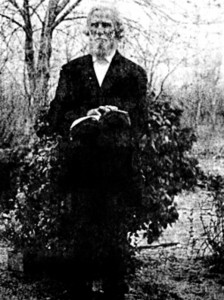 Bible. I’m sure that in the early years he was a preacher of sorts…at least in his family. That reminds me a lot of my dad, in that he was the patriarch of our family. We always looked to him to have the answers and to show us the right way to go in all things. I doubt if any of us would have been who we are today, had it not been for that leading. I can’t say for sure if Angeloah was the same kind of father to his children. Those were very different times, and parenting was different too, so I can’t say what his parenting style was like or what part his faith played in his parenting style.
Bible. I’m sure that in the early years he was a preacher of sorts…at least in his family. That reminds me a lot of my dad, in that he was the patriarch of our family. We always looked to him to have the answers and to show us the right way to go in all things. I doubt if any of us would have been who we are today, had it not been for that leading. I can’t say for sure if Angeloah was the same kind of father to his children. Those were very different times, and parenting was different too, so I can’t say what his parenting style was like or what part his faith played in his parenting style.
Basically, that is all I know of my 3rd great grandfather. That makes me sad in many ways. It seems like some families didn’t keep records that were up to date as much as other families. I had hoped that with the abundance of pictures out there, I would be able to find much more documentation on him and his life, as well as his parents. Instead, I am left with nothing but the continuing mystery of Angeloah Shaw.
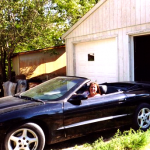 Driving home the other day, I started thinking about being in charge of such a machine as the automobile. At 15 years of age, most kids start learning to control this machine, and in a very short time, they are good at it. With the turn of a wheel and the press of a foot on a pedal, the car moves and the driver is in control. With careful and responsible use, the car can be maneuvered safely down life’s roads…and while driving it, we give little or no thought to just how amazing that is. A car is no small thing, and trucks are even bigger, and yet they are driven around by people who are pretty much one tenth of their size…sometimes less than that. Am I the only one who thinks about that?
Driving home the other day, I started thinking about being in charge of such a machine as the automobile. At 15 years of age, most kids start learning to control this machine, and in a very short time, they are good at it. With the turn of a wheel and the press of a foot on a pedal, the car moves and the driver is in control. With careful and responsible use, the car can be maneuvered safely down life’s roads…and while driving it, we give little or no thought to just how amazing that is. A car is no small thing, and trucks are even bigger, and yet they are driven around by people who are pretty much one tenth of their size…sometimes less than that. Am I the only one who thinks about that?
Before the invention of the automobile, people did control wagons and horse drawn carriages, but the horse had some say in what happened…at least to the extent that it wouldn’t usually go running off a cliff. And maybe  it wasn’t a good thing to have the horse involved exactly, because it could fight against the driver…unlike the automobile. Nevertheless, to have a machine that you have to control or it will go out of control, and to think that kids as young as fifteen are controlling that vehicle, is amazing and even mind boggling to me. And yet, it is being safely done every day.
it wasn’t a good thing to have the horse involved exactly, because it could fight against the driver…unlike the automobile. Nevertheless, to have a machine that you have to control or it will go out of control, and to think that kids as young as fifteen are controlling that vehicle, is amazing and even mind boggling to me. And yet, it is being safely done every day.
I’m not sure just why it sometimes hits me that driving a car every day is amazing, but it does. And when my kids and grandkids started driving, it seemed even more strange to me. How could they possibly know how to handle such a machine? They couldn’t possibly be ready or capable of such a thing, but the reality is that just like me, they were ready for it. There are approximately 30,000,000 drivers in the United States today, and if even a third of them are kids, there are about 10,000,000 kids driving their cars, and most generally keeping them in their own lane and on the road. I don’t say that driving a car is the safest way to travel, because like it  or not, that honor belongs to the airlines. Many people wouldn’t agree, but the numbers don’t lie.
or not, that honor belongs to the airlines. Many people wouldn’t agree, but the numbers don’t lie.
I know my thoughts sometimes seem a little odd, but the next time you get behind the wheel, contemplate for a moment just how amazing it is that you operate a piece of machinery that is about ten times your size and you do it while giving it almost no thought at all. I guess that our minds grasp many things, and driving a car doesn’t seem to be a particularly difficult one, since it is something we master at a relatively young age. A vehicle is a complicated piece of machinery with many things to master, but we have been doing it for a long time…truly amazing.
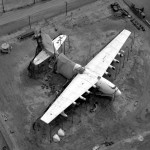 Since man first learned to fly, there have been many kinds of planes. It seems like everyone is trying to improve on them. Hollywood producer, Howard Hughes was one of the people who wanted to do something new with planes, so he founded Hughes Aircraft Company in 1932. He tested cutting-edged aircraft that he had designed and in 1937 broke the transcontinental flight-time record. He then broke the world record in 1938 by flying around the world in 19 hours and 14 minutes. Those were amazing feats, but it was another of his planes that caught my dad’s interest.
Since man first learned to fly, there have been many kinds of planes. It seems like everyone is trying to improve on them. Hollywood producer, Howard Hughes was one of the people who wanted to do something new with planes, so he founded Hughes Aircraft Company in 1932. He tested cutting-edged aircraft that he had designed and in 1937 broke the transcontinental flight-time record. He then broke the world record in 1938 by flying around the world in 19 hours and 14 minutes. Those were amazing feats, but it was another of his planes that caught my dad’s interest.
After the United States entered World War II, the government asked Hughes Aircraft Company to build a large flying boat capable of transporting men and materials very long distances. The concept had originally been that of Henry Kiser, but he dropped out and Howard Hughes took over. The plane was built mostly of birch, but also of spruce, due to wartime restrictions on the use of steel. The wood was laminated with plastic and covered in fabric. The design gave the plane a gray/white color, and since spruce was used in the design, the plane was dubbed the Spruce Goose. The plan was for it to be able to transport 700 men at a time. The plane had a wingspan of 320 feet and it was powered by eight propeller engines and was designed to take off and land on the water. It’s first and last flight was on November 2, 1947. It wasn’t originally intended to be a flight, but just a taxi trip on Long Beach Harbor. Howard Hughes decided on a whim to fly it. It flew 70 feet over the water for one mile before landing successfully.
Since me dad had built planes at Douglas Aircraft Company before going into the service during World War II, the Spruce Goose really intrigued him. It was such a novelty…whether it was supposed to be or not. When Mom and Dad were in McMinnville, Oregon, they finally had the opportunity to visit the Evergreen Aviation Museum 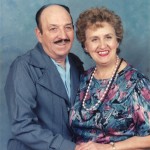 and see the Spruce Goose for themselves. I can just hear the thoughts going through my dad’s head the moment he saw it. I’ll bet it was all he could do, not to jump up and down with excitement. I’m sure it was an awesome moment.
and see the Spruce Goose for themselves. I can just hear the thoughts going through my dad’s head the moment he saw it. I’ll bet it was all he could do, not to jump up and down with excitement. I’m sure it was an awesome moment.
I don’t know if Dad ever saw the video of the first and only flight of the Spruce Goose or not, but I have had the chance to see it. It was amazing to see a plane with a wingspan that was longer than a football field actually be able to get in the air. To me though, it seemed like that flight took a lot of effort. I don’t think I would have wanted to trust it to fly the long distance flights to Europe and such. Still, it flew, and it is the largest plane, and no one can take those things away from the Spruce Goose.
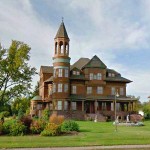 While in Superior, Wisconsin in late August, we drove by a beautiful home, called the Fairlawn Mansion. I have always been intrigued by mansions. It isn’t that I would like to live in one necessarily, but I very much enjoy going through them. We didn’t have time to go through this one, unfortunately, so I have been doing some research on it. My research has helped to tie a couple of things together for me about my hometown. I was born in Superior, but that doesn’t necessarily mean that I know a lot about the history there…especially since we moved when I was three years old. I never knew who the mayors were for instance, or why some of the places were named what they are.
While in Superior, Wisconsin in late August, we drove by a beautiful home, called the Fairlawn Mansion. I have always been intrigued by mansions. It isn’t that I would like to live in one necessarily, but I very much enjoy going through them. We didn’t have time to go through this one, unfortunately, so I have been doing some research on it. My research has helped to tie a couple of things together for me about my hometown. I was born in Superior, but that doesn’t necessarily mean that I know a lot about the history there…especially since we moved when I was three years old. I never knew who the mayors were for instance, or why some of the places were named what they are.
I knew about Pattison Park, but never knew how it got it’s name. It was named after Superior’s three time mayor, Martin Pattison. He was a lumber and mining baron, and he built the Fairlawn Mansion as the family home for himself, his wife and their six children. Construction began in 1889 and was completed in 1891. It is known as one of America’s castles, and it definitely looks the part. It is a 42 room mansion with a four story turret complete with a widow’s watch overlooking the bay at the tip of Lake Superior. The cost of building the mansion was $150,000 at that time, which is equivalent to well over $3,000,000 today. The grounds are adorned with several gardens filled with flowers in the summertime.
The family lived in the home until Martin’s passing in 1918, and the home sat vacant until 1920. From 1920 to 1962, this mansion served as a children’s home and house for the less fortunate. To me that seems a bit odd. Not that the house would be used in this manner, but that the people who benefitted from it’s use in those days would be called less fortunate…since they did have an amazing home to live in. Of course, if they were orphaned, they would be less fortunate. Nevertheless, they had an amazing house to live in. I can imagine that if those walls could talk, they would have many stories of the laughter of children to tell, because the mansion housed over 2000 children during it’s 42 years as a children’s home.
There are always a few ghost stories associated with mansions, it seems, and this mansion is no exception. It is said that a former maid, who was later killed by her husband and a little girl who supposedly drowned in the pool both haunt the mansion to this day, but I don’t believe in ghosts, so I say that only in passing, since it is a story connected to this beautiful house. Neither of these accounts can be substantiated, and there is no record of anyone dying there. I’m not sure why it is always the mansions that seem to carry the haunted status, because quite likely every older home and even many of the newer ones have had a resident die in them, and I’m sure quite a few of the deaths involved murder, but you just never hear of ghosts 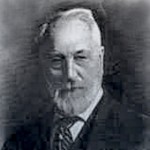 haunting those places. Maybe the story just doesn’t fit in with a dinky little house.
haunting those places. Maybe the story just doesn’t fit in with a dinky little house.
Rather than the supposed ghosts a mansion might have, I prefer to think of the happy times the mansion got to see over the years. These days the house is a museum, and hosts many weddings. I can imagine that the ballroom would be fabulous, and such a romantic place to have a wedding party. If the couple planned it right, theirs could be a replica of a traditional high society wedding of days gone by. I would imaging that if these walls could talk, we could hear stories of beautiful gowns, elegant people, and beautiful music. This mansion has such a unique history, that I would really love to sit and hear all it one day, because the stories would have to be simply amazing.
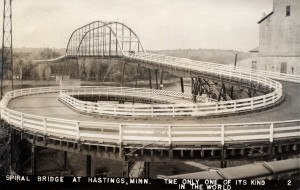 I never knew my dad to be a big sentimental saver, who kept every little knick knack or scrap of paper, so when he saved something, I have to think that it meant something, or was something special to him. Pictures were the exception, of course, but I was surprised when I found a couple of post cards from his sister, my Aunt Ruth when she was on a trip in 1946. She doesn’t say who she was with, but since she was married at the time, I have to assume that she was with my Uncle Jim. One post card, in particular, stood out for me, mostly I suppose because I like things of historic value. The post card was of the Spiral Bridge in Hastings, Minnesota. Hastings is in southern Minnesota, and while I would have a hard time believing that my dad never made the trip down to see this famous wagon bridge, I have no real proof that he was ever there, but I believe Aunt Ruth went over it on the trip back in May of 1946. Still, whether Dad went over it or not, he must have thought it quite interesting, because he kept the card the rest of his life. Dad was always interested in the historic value of things too, and I’m sure that is where my interest in those things began. He took the time to show us many historic markers and places of interest.
I never knew my dad to be a big sentimental saver, who kept every little knick knack or scrap of paper, so when he saved something, I have to think that it meant something, or was something special to him. Pictures were the exception, of course, but I was surprised when I found a couple of post cards from his sister, my Aunt Ruth when she was on a trip in 1946. She doesn’t say who she was with, but since she was married at the time, I have to assume that she was with my Uncle Jim. One post card, in particular, stood out for me, mostly I suppose because I like things of historic value. The post card was of the Spiral Bridge in Hastings, Minnesota. Hastings is in southern Minnesota, and while I would have a hard time believing that my dad never made the trip down to see this famous wagon bridge, I have no real proof that he was ever there, but I believe Aunt Ruth went over it on the trip back in May of 1946. Still, whether Dad went over it or not, he must have thought it quite interesting, because he kept the card the rest of his life. Dad was always interested in the historic value of things too, and I’m sure that is where my interest in those things began. He took the time to show us many historic markers and places of interest.
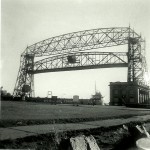 The Spiral Bridge was built over the Mississippi River in 1895 as a wagon bridge. It was built with a large spiral ramp on the south end to allow enough clearance for the river traffic to pass below the bridge. These days we would have a vertical lift bridge, such as the one at Duluth Harbor, or a draw bridge, like the Tower Bridge, but back then, they didn’t have the capability to build such a bridge and the river traffic had to get through. The Spiral Bridge easily handled the river traffic and the wagon traffic. In 1895, there weren’t many cars around, and most people still traveled by horse and wagon. A bridge that had too steep a rise would be really hard for horses, so it was necessary, for the sake of continuing the movement of river traffic, to create a ramp of sorts so the bridge was high enough. The spiral ramp on the Spiral Bridge did just that.
The Spiral Bridge was built over the Mississippi River in 1895 as a wagon bridge. It was built with a large spiral ramp on the south end to allow enough clearance for the river traffic to pass below the bridge. These days we would have a vertical lift bridge, such as the one at Duluth Harbor, or a draw bridge, like the Tower Bridge, but back then, they didn’t have the capability to build such a bridge and the river traffic had to get through. The Spiral Bridge easily handled the river traffic and the wagon traffic. In 1895, there weren’t many cars around, and most people still traveled by horse and wagon. A bridge that had too steep a rise would be really hard for horses, so it was necessary, for the sake of continuing the movement of river traffic, to create a ramp of sorts so the bridge was high enough. The spiral ramp on the Spiral Bridge did just that.
With his interest in historic, and unique things, I can hardly imagine that this historic bridge would be the thing my dad would have missed. Sadly, it is not something we can go see today, because it was torn down in 1951 to make way for a high bridge that would provide a straighter entry and make modern day traffic flow more smoothly. The spiral ramp, while a great idea for wagons, slowed automobile traffic considerably. With the  modern day automobile, came the need for a new bridge, and the Spiral Bridge, while historic and unique, was nevertheless obsolete. I suppose the builders of the new bridge were excited to see a brand new, modern bridge take the place of the old, outdated bridge, but I like antiques. Houses, bridges, furniture, and even cars, provided that I don’t have to drive them much, all hold my interest, but there are people who prefer to have everything very modern. I suppose too, that it was a necessity, and they just couldn’t move the new one to a different location. Whatever the case may have been, I’m glad my Aunt Ruth and Uncle Jim got to see it, and I really hope my dad and the rest of the family did too. It was a little bit of history that I know they would have loved. Bridges are cool, but the Spiral Bridge was amazing.
modern day automobile, came the need for a new bridge, and the Spiral Bridge, while historic and unique, was nevertheless obsolete. I suppose the builders of the new bridge were excited to see a brand new, modern bridge take the place of the old, outdated bridge, but I like antiques. Houses, bridges, furniture, and even cars, provided that I don’t have to drive them much, all hold my interest, but there are people who prefer to have everything very modern. I suppose too, that it was a necessity, and they just couldn’t move the new one to a different location. Whatever the case may have been, I’m glad my Aunt Ruth and Uncle Jim got to see it, and I really hope my dad and the rest of the family did too. It was a little bit of history that I know they would have loved. Bridges are cool, but the Spiral Bridge was amazing.
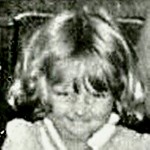 So many of us would love to know more about our family and the stories from the past, but by the time we realize that we are interested in those stories, the people who could tell us about them are gone, and it is too late. I feel very blessed that my grandparents had nine children, all spaced roughly 2 years apart. My aunt, Sandy Pattan was the youngest of those children. While the older children lived some things that Aunt Sandy was to young to have lived, she was nevertheless, not to young to have heard all the stories, and she was just curious enough to be a willing listener. While her older siblings were growing up and doing all the things a kid sister finds very cool, Aunt Sandy was watching with curiosity. She wanted to grow up just like her sisters, and she loved watching her brothers’ antics, as well as, their kindnesses. She also watched her parents, aunts, uncles, cousins, and grandparents…and she listened to the stories that were told.
So many of us would love to know more about our family and the stories from the past, but by the time we realize that we are interested in those stories, the people who could tell us about them are gone, and it is too late. I feel very blessed that my grandparents had nine children, all spaced roughly 2 years apart. My aunt, Sandy Pattan was the youngest of those children. While the older children lived some things that Aunt Sandy was to young to have lived, she was nevertheless, not to young to have heard all the stories, and she was just curious enough to be a willing listener. While her older siblings were growing up and doing all the things a kid sister finds very cool, Aunt Sandy was watching with curiosity. She wanted to grow up just like her sisters, and she loved watching her brothers’ antics, as well as, their kindnesses. She also watched her parents, aunts, uncles, cousins, and grandparents…and she listened to the stories that were told.
Flash forward to today, and to her niece…me, who is curious about all those events from the past. I have asked other family members about those events, and received a little bit of information, but my Aunt Sandy has an amazing mind. Not to brag…but I think I take after her in that area. Once a story is told to her…she stores in I her memory files for all time, and she can pull it out and accurately pass on the details to those around her, who want to know, and are blessed enough to realize that she is an such amazing store of information. There is just no need to be in the dark about our family history, because if the information is out there, Aunt Sandy probably has it.
Aunt Sandy retired a while back, and is busy with a lot of projects, but she has it in her heart to put some of 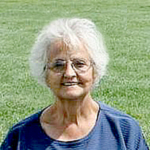 this information on paper, so that it can be passed on to other interested family members. I really hope she does that, because it is so easy for those stories to get lost and forgotten in time. Those who remember them pass away, and if they didn’t tell others the stories, they are lost. Aunt Sandy has a real talent for remembering the events as they happened, and for telling them in a way that makes them interesting to the listener. I have very much enjoyed listening to her accounts of the events of her life, and the ones that shaped it…as well as mine, and the rest of the family. Next time you get an opportunity, I strongly recommend that you take the time to talk to her about your history. You will be amazed at what you might find out. Today is Aunt Sandy’s birthday. Happy birthday Aunt Sandy!! Have a great day!! We love you!!
this information on paper, so that it can be passed on to other interested family members. I really hope she does that, because it is so easy for those stories to get lost and forgotten in time. Those who remember them pass away, and if they didn’t tell others the stories, they are lost. Aunt Sandy has a real talent for remembering the events as they happened, and for telling them in a way that makes them interesting to the listener. I have very much enjoyed listening to her accounts of the events of her life, and the ones that shaped it…as well as mine, and the rest of the family. Next time you get an opportunity, I strongly recommend that you take the time to talk to her about your history. You will be amazed at what you might find out. Today is Aunt Sandy’s birthday. Happy birthday Aunt Sandy!! Have a great day!! We love you!!

